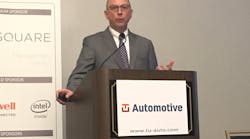ATLANTA. In a world where trucks are able to fully drive themselves, there still will be a role for the commercial driver. But that role is going to change.
Michael Cammisa, vice president of safety policy, connectivity and technology, for the American Trucking Assns., discussed technology, policy and businesses perspectives as they relate to driving change in automated trucking during TU-Automotive’s Connected Fleets conference here in Atlanta.
With growing freight demand, a demand for more trucks, and a projected driver shortage of up to 175,000 by 2024, Cammisa said the industry is looking to automation to attract new, younger drivers.
“I heard a fleet manager say he already has driverless trucks … they’re in the parking lot now and if he could just get drivers for them he could make more money,” Cammisa quipped.
“We’re looking at this technology right now as more of a driver-assist feature to make the drivers safer and more productive,” he added. “We also hope it’s going to extend the careers of some of the older drivers rather than put them out of jobs. And we’re also hoping it’s going to attract younger drivers – particularly in the long-haul segments where people are away for days at a time and don’t know when exactly they’re going to be home again.”
An example of automation to make a driver more productive could be that the vehicle takes over when a driver is stuck in some sort of traffic jam and has trouble making his or her final deliveries. With that driver-assistive software, Cammisa explained the truck could handle that stop-and-go traffic and extend the driver’s hours of service so he or she can make that final delivery on time.
In terms of jobs, the industry is also thinking of technicians, Cammisa noted.
“We need more [technicians] now, and with new technology there are going to be new requirements for maintaining and repairing that technology on the vehicles, so we think this will be a great opportunity and also provide a new skillset for the technicians that are in fleets now,” he added.
Some of the main hurdles the industry is currently dealing with are state laws and regulations. Cammisa noted that if states have conflicting requirements that could lead to problems for interstate commerce – creating an inevitable slowdown in the development of automated technology.
“This is a case where the technology is being developed really fast and people are trying to regulate it before it’s actually been fully developed,” he explained, adding this wasn’t the case for implementing and mandating automatic emergency braking systems or electronic stability control. “With the automated technology, we’re seeing efforts where we’re trying to regulate it and we don’t really have all the information yet.”




